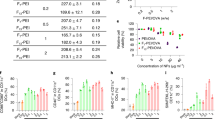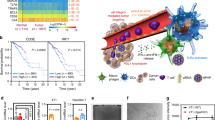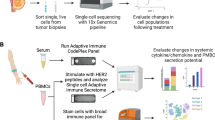Abstract
Cancer vaccines hold great promise for improved cancer treatment. However, endosomal trapping and low immunogenicity of tumour antigens usually limit the efficiency of vaccination strategies. Here, we present a proton-driven nanotransformer-based vaccine, comprising a polymer–peptide conjugate-based nanotransformer and loaded antigenic peptide. The nanotransformer-based vaccine induces a strong immune response without substantial systemic toxicity. In the acidic endosomal environment, the nanotransformer-based vaccine undergoes a dramatic morphological change from nanospheres (about 100 nanometres in diameter) into nanosheets (several micrometres in length or width), which mechanically disrupts the endosomal membrane and directly delivers the antigenic peptide into the cytoplasm. The re-assembled nanosheets also boost tumour immunity via activation of specific inflammation pathways. The nanotransformer-based vaccine effectively inhibits tumour growth in the B16F10-OVA and human papilloma virus-E6/E7 tumour models in mice. Moreover, combining the nanotransformer-based vaccine with anti-PD-L1 antibodies results in over 83 days of survival and in about half of the mice produces complete tumour regression in the B16F10 model. This proton-driven transformable nanovaccine offers a robust and safe strategy for cancer immunotherapy.
This is a preview of subscription content, access via your institution
Access options
Access Nature and 54 other Nature Portfolio journals
Get Nature+, our best-value online-access subscription
$29.99 / 30 days
cancel any time
Subscribe to this journal
Receive 12 print issues and online access
$259.00 per year
only $21.58 per issue
Buy this article
- Purchase on Springer Link
- Instant access to full article PDF
Prices may be subject to local taxes which are calculated during checkout






Similar content being viewed by others
Data availability
All relevant data during the study are available from the corresponding authors upon request. Source data are provided with this paper.
References
Irvine, D. J., Hanson, M. C., Rakhra, K. & Tokatlian, T. Synthetic nanoparticles for vaccines and immunotherapy. Chem. Rev. 115, 11109–11146 (2015).
Kuai, R., Ochyl, L. J., Bahjat, K. S., Schwendeman, A. & Moon, J. J. Designer vaccine nanodiscs for personalized cancer immunotherapy. Nat. Mater. 161, 489–496 (2016).
Sahin, U. et al. Personalized RNA mutanome vaccines mobilize poly-specific therapeutic immunity against cancer. Nature 547, 222–226 (2017).
Ott, P. A. et al. An immunogenic personal neoantigen vaccine for patients with melanoma. Nature 547, 217–221 (2017).
Goldberg, M. S. Immunoengineering: how nanotechnology can enhance cancer immunotherapy. Cell 161, 201–204 (2015).
Chou, L. Y., Ming, K. & Chan, W. C. Strategies for the intracellular delivery of nanoparticles. Chem. Soc. Rev. 40, 233–245 (2011).
Yin, H. et al. Non-viral vectors for gene-based therapy. Nat. Rev. Genet. 15, 541–555 (2014).
Douat, C. et al. A cell-penetrating foldamer with a bioreducible linkage for intracellular delivery of DNA. Angew. Chem. Int. Ed. 54, 11133–11137 (2015).
D’Astolfo, D. S. et al. Efficient intracellular delivery of native proteins. Cell 161, 674–690 (2015).
Stewart, M. P. et al. In vitro and ex vivo strategies for intracellular delivery. Nature 538, 183–192 (2016).
Blanco, E., Shen, H. & Ferrari, M. Principles of nanoparticle design for overcoming biological barriers to drug delivery. Nat. Biotechnol. 33, 941–951 (2015).
Kanasty, R., Dorkin, J. R., Vegas, A. & Anderson, D. Delivery materials for siRNA therapeutics. Nat. Mater. 12, 967–977 (2013).
Luo, M. et al. A STING-activating nanovaccine for cancer immunotherapy. Nat. Nanotech. 12, 648–654 (2017).
Cheng, Y., Yumul, R. C. & Pun, S. H. Virus-inspired polymer for efficient in vitro and in vivo gene delivery. Angew. Chem. Int. Ed. 128, 12192–12196 (2016).
Martens, T. F., Remaut, K., Demeester, J., De Smedt, S. C. & Braeckmans, K. Intracellular delivery of nanomaterials: how to catch endosomal escape in the act. Nano Today 9, 344–364 (2014).
Akishiba, M. et al. Cytosolic antibody delivery by lipid-sensitive endosomolytic peptide. Nat. Chem. 9, 751–761 (2017).
Cheng, C. J. et al. MicroRNA silencing for cancer therapy targeted to the tumour microenvironment. Nature 518, 107–110 (2015).
Keller, S. et al. Neutral polymer micelle carriers with pH-responsive, endosome-releasing activity modulate antigen trafficking to enhance CD8+ T cell responses. J. Control. Release 191, 24–33 (2014).
Shae, D. et al. Endosomolytic polymersomes increase the activity of cyclic dinucleotide STING agonists to enhance cancer immunotherapy. Nat. Nanotech. 14, 269–278 (2019).
Wilson, J. T. et al. Enhancement of MHC-I antigen presentation via architectural control of pH-responsive, endosomolytic polymer nanoparticles. AAPS J. 17, 358–369 (2015).
Xia, X. et al. Porous silicon microparticle potentiates anti-tumor immunity by enhancing cross-presentation and inducing type interferon response. Cell Rep. 11, 957–966 (2015).
Morishita, M., Takahashi, Y., Matsumoto, A., Nishikawa, M. & Takakura, Y. Exosome-based tumor antigens-adjuvant co-delivery utilizing genetically engineered tumor cell-derived exosomes with immunostimulatory CpG DNA. Biomaterials 111, 55–65 (2016).
Wilson, D. S. et al. Antigens reversibly conjugated to a polymeric glyco-adjuvant induce protective humoral and cellular immunity. Nat. Mater. 18, 175–185 (2019).
Riley, R. S., June, C. H., Langer, R. & Mitchell, M. J. Delivery technologies for cancer immunotherapy. Nat. Rev. Drug Discov. 18, 175–196 (2019).
Tanyi, J. L. et al. Personalized cancer vaccine effectively mobilizes antitumor T cell immunity in ovarian cancer. Sci. Transl. Med. 10, eaao5931 (2018).
Chiefari, J. et al. Living free-radical polymerization by reversible addition-fragmentation chain transfer: the RAFT process. Macromolecules 31, 5559–5562 (1998).
Zhou, J., Du, X., Yamagata, N. & Xu, B. Enzyme-instructed self-assembly of small d-peptides as a multiple-step process for selectively killing cancer cells. J. Am. Chem. Soc. 138, 3813–3823 (2016).
Zhong, Y. et al. Hyaluronic acid-shelled acid-activatable paclitaxel prodrug micelles effectively target and treat CD44-overexpressing human breast tumor xenografts in vivo. Biomaterials 84, 250–261 (2016).
Zambaux, M. et al. Influence of experimental parameters on the characteristics of poly (lactic acid) nanoparticles prepared by a double emulsion method. J. Control. Release 50, 31–40 (1998).
Wilhelm, C., Cebers, A., Bacri, J.-C. & Gazeau, F. Deformation of intracellular endosomes under a magnetic field. Eur. Biophys. J. 32, 655–660 (2003).
Gong, N. et al. Carbon-dot-supported atomically dispersed gold as a mitochondrial oxidative stress amplifier for cancer treatment. Nat. Nanotech. 14, 379–387 (2019).
Qiu, L. et al. Self-assembled pH-responsive hyaluronic acid–g-poly (l-histidine) copolymer micelles for targeted intracellular delivery of doxorubicin. Acta Biomater. 10, 2024–2035 (2014).
Alam, M. M. et al. Endogenous inspired biomineral-installed hyaluronan nanoparticles as pH-responsive carrier of methotrexate for rheumatoid arthritis. J. Control. Release 252, 62–72 (2017).
Zhang, Z. et al. Mesoporous silica-coated gold nanorods as a light-mediated multifunctional theranostic platform for cancer treatment. Adv. Mater. 24, 1418–1423 (2012).
Petersen, N. H., Kirkegaard, T. & Jäättelä, M. Lysosomal stability assay. Bio Protoc. 4, e1162 (2014).
Aits, S. et al. Sensitive detection of lysosomal membrane permeabilization by lysosomal galectin puncta assay. Autophagy 11, 1408–1424 (2015).
Goel, S. et al. CDK4/6 inhibition triggers anti-tumour immunity. Nature 548, 471 (2017).
Fan, Y. et al. Immunogenic cell death amplified by co-localized adjuvant delivery for cancer immunotherapy. Nano Lett. 17, 7387–7393 (2017).
Duan, F. et al. A simple and powerful co-delivery system based on pH-responsive metal-organic frameworks for enhanced cancer immunotherapy. Biomaterials 122, 23–33 (2017).
Li, A. V. et al. Generation of effector memory T cell-based mucosal and systemic immunity with pulmonary nanoparticle vaccination. Sci. Transl. Med. 5, 204ra130 (2013).
Rosenthal, A. K. & Ryan, L. M. Calcium pyrophosphate deposition disease. N. Engl. J. Med. 374, 2575–2584 (2016).
Martinon, F., Pétrilli, V., Mayor, A., Tardivel, A. & Tschopp, J. Gout-associated uric acid crystals activate the NALP3 inflammasome. Nature 440, 237–241 (2006).
Heneka, M. T. et al. NLRP3 is activated in Alzheimer’s disease and contributes to pathology in APP/PS1 mice. Nature 493, 674–678 (2013).
Ghiringhelli, F. et al. Activation of the NLRP3 inflammasome in dendritic cells induces IL-1β-dependent adaptive immunity against tumors. Nat. Med. 15, 1170–1178 (2009).
Coll, R. C. et al. A small-molecule inhibitor of the NLRP3 inflammasome for the treatment of inflammatory diseases. Nat. Med. 21, 248–255 (2015).
Brewer, J. M. et al. Aluminium hydroxide adjuvant initiates strong antigen-specific Th2 responses in the absence of IL-4-or IL-13-mediated signaling. J. Immunol. 163, 6448–6454 (1999).
Garaude, J., Kent, A., van Rooijen, N. & Blander, J. M. Simultaneous targeting of toll-and nod-like receptors induces effective tumor-specific immune responses. Sci. Transl. Med. 4, 120ra116 (2012).
Guo, Y., Lei, K. & Tang, L. Neoantigen vaccine delivery for personalized anticancer immunotherapy. Front. Immunol. 9, 1499 (2018).
Chu, Y., Liu, Q., Wei, J. & Liu, B. Personalized cancer neoantigen vaccines come of age. Theranostics 8, 4238 (2018).
Li, A. W. et al. A facile approach to enhance antigen response for personalized cancer vaccination. Nat. Mater. 17, 528 (2018).
Niikura, K. et al. Gold nanoparticles as a vaccine platform: influence of size and shape on immunological responses in vitro and in vivo. ACS nano 7, 3926–3938 (2013).
Yang, Y.-Y., Chung, T.-S. & Ng, N. P. Morphology, drug distribution, and in vitro release profiles of biodegradable polymeric microspheres containing protein fabricated by double-emulsion solvent extraction/evaporation method. Biomaterials 22, 231–241 (2001).
Ellens, H., Bentz, J. & Szoka, F. C. pH-induced destabilization of phosphatidylethanolamine-containing liposomes: role of bilayer contact. Biochemistry 23, 1532–1538 (1984).
Acknowledgements
This work was financially supported by the National Natural Science Foundation of China (grant numbers 31630027, 31430031, 21327806, 21621003 and 21235004) and NSFC-German Research Foundation (DFG) project (grant number 31761133013). We are grateful for support from the Strategic Priority Research Program of the Chinese Academy of Sciences (grant numbers XDA09030301 and XDB36000000), the National Key Research and Development Program of China (grant numbers 2018YFE0117800 and 2016YFA0203101). We also acknowledge support from the NIH/NIMHHD (grant number U54MD007597). We thank Z. Ao for help with the AFM measurements and X. Hu and H. Guo for help with the TEM analysis.
Author information
Authors and Affiliations
Contributions
N.G., J.L. and X.-J.L. conceived and designed the experiments. N.G., Y.Z., X.T., Yongchao Wang, S.H., G.Q., Q.N., X.L., J.W., X.Y., T.Z., S.C. and Yongji Wang performed the experiments. N.G., X.Y., T.Z., J.L. and X.-J.L. analysed the results. J.Y., Y.G., J.Z., P.C.W and M.J.M. developed the discussion. N.G., J.L. and X.-J.L. wrote the manuscript. J.L. and X.-J.L. supervised the entire project. All authors discussed the results and commented on the manuscript.
Corresponding authors
Ethics declarations
Competing interests
The authors declare no competing financial interests.
Additional information
Peer review information Nature Nanotechnology thanks Rona Chandrawati, Bartosz Grzybowski, Jeffrey Hubbell and the other, anonymous, reviewer(s) for their contribution to the peer review of this work.
Publisher’s note Springer Nature remains neutral with regard to jurisdictional claims in published maps and institutional affiliations.
Supplementary information
Supplementary Information
Supplementary Figures 1–42, Supplementary Tables 1–3.
Source data
Source Data Fig. 2
Numerical data used to generate graphs in Fig. 2
Source Data Fig. 3
Numerical data used to generate graphs in Fig. 3
Source Data Fig. 4
Numerical data used to generate graphs in Fig. 4
Source Data Fig. 5
Numerical data used to generate graphs in Fig. 5
Source Data Fig. 6
Numerical data used to generate graphs in Fig. 6
Rights and permissions
About this article
Cite this article
Gong, N., Zhang, Y., Teng, X. et al. Proton-driven transformable nanovaccine for cancer immunotherapy. Nat. Nanotechnol. 15, 1053–1064 (2020). https://doi.org/10.1038/s41565-020-00782-3
Received:
Accepted:
Published:
Issue Date:
DOI: https://doi.org/10.1038/s41565-020-00782-3
This article is cited by
-
The quest for nanoparticle-powered vaccines in cancer immunotherapy
Journal of Nanobiotechnology (2024)
-
All-Rounder Liposomes in Cancer Immunotherapy: Strategies and Design Applications of Engineered Liposomal Nanomaterials
BioChip Journal (2024)
-
Inhibiting PI3K/AKT/mTOR signaling by metal-organic frameworks for overcoming multiple drug resistance in chemoradiotherapy
Science China Materials (2024)
-
Targeting lymph node delivery with nanovaccines for cancer immunotherapy: recent advances and future directions
Journal of Nanobiotechnology (2023)
-
Responsive biomaterials: optimizing control of cancer immunotherapy
Nature Reviews Materials (2023)



